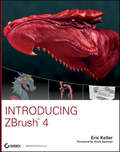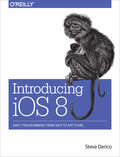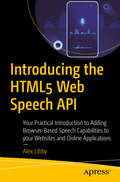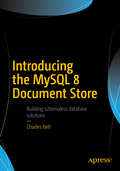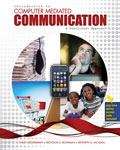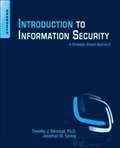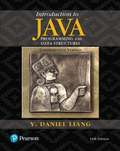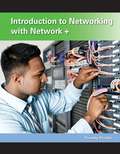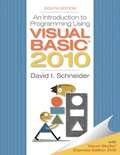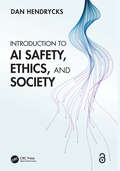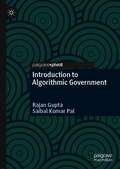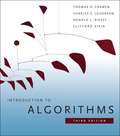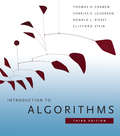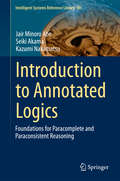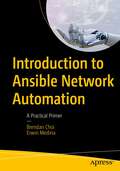- Table View
- List View
Introducing ZBrush
by Eric KellerIf you want to take advantage of one of the hottest CG tools available, Introducing ZBrush is the perfect place to start.Introducing ZBrush helps you jump into this exciting drawing and sculpting software without fear. Learn ZBrush 3.1 basics inside and out and get comfortable sculpting in a digital environment with this relaxed, friendly, and thorough guide. Master these practical techniques and soon you'll be creating realistic, cartoon, and organic models with flair.Introduces you to ZBrush 3.1, the sculpting software that lets you create digital art with a fine-art feel, which you can transfer into Maya or other 3D applicationsCovers painting, meshes, organic sculpting, hard surface sculpting, textures, lighting, rendering, working with other 3D applications, and scriptingWalks you through a series of fun and engaging tutorials where you can start creating your own work, including human, cartoon, and organic modelsLearn to create lush, beautiful digital art with ZBrush and this detailed guide.
Introducing ZBrush 3rd Edition
by Eric KellerLearn ZBrush inside and out with this updated new editionGet totally comfortable sculpting in a digital environment with the latest edition of this bestselling beginner's guide to ZBrush. Fully updated for the newest version of the software, ZBrush 4R3, this book dispels any fears you might have about the difficulty of using ZBrush and soon has you creating realistic, cartoon, and organic models with flair. Learn all the essentials, as you complete fun tutorials on painting, meshes, organic scripting, hard surface sculpting, lighting, rendering, and more.Introduces you to ZBrush, the sculpting software that lets you create digital art with a fine-art feel, which you can transfer into Maya or other 3D applications Covers painting, meshes, organic sculpting, hard surface sculpting, textures, lighting, rendering, working with other 3D applications, and scripting Walks you through a series of fun and engaging tutorials where you can start creating your own work, including human, cartoon, and organic models Fully updated for the newest version of ZBrush, ZBrush 4R3, including full coverage of its robust rendering tools Includes a DVD with helpful video examples and files to help you complete the tutorialsDesign remarkably realistic creatures, people, and objects with ZBrush and the new edition of this top-selling guide.The DVD is not included as part of the e-book file, but is available for download after purchase.
Introducing iOS 8: Swift Programming from Idea to App Store
by Steve DericoLearn to make iOS apps even if you have absolutely no programming experience. This hands-on book takes you from idea to App Store, using real-world examples—such as driving a car or eating at a restaurant—to teach programming and app development. You’ll learn concepts through clear, concise, jargon-free language.This book focuses on Apple’s new programming language, Swift. Each lesson is divided into two parts: the lecture portion explains the terms and concepts through examples, and the exercise portion helps you apply these concepts while building real-world apps, like a tip calculator. Learn how to think differently—and see the world from a whole new perspective.Learn the basic building blocks of programmingDive into the Swift programming languageMake apps for iPhone and iPadUse GPS in your app to find a user’s locationTake or select photos with your appIntegrate your app with Facebook and TwitterSubmit your app to the App StoreManage and market your app on the App Store
Introducing the HTML5 Web Speech API: Your Practical Introduction to Adding Browser-Based Speech Capabilities to your Websites and Online Applications
by Alex LibbyLeverage the power of HTML5 Web Speech API to quickly add voice capabilities to your websites. This project-oriented book simplifies the process of setting up and manipulating the API in the browser using little more than a text editor or free software. You'll be presented with a starting toolset that you can use to develop future projects, incorporate into your existing workflow and allow you to take your websites to the next level, reducing the reliance on entering choices through a keyboard and making the overall experience easier for customers. This excellent resource is perfect for getting acquainted with creating and manipulating browser-based APIs. You don’t have to convert your whole work process immediately; you can incorporate as little or as much as you want of the API, and build on this as your skills develop. We live in an age where speed and simplicity are of the essence – this book provides a perfect way to add speech capabilities to our websites, directly in the browser and with the minimum of fuss.Introducing the HTML5 Web Speech API is the right choice for developers who want to focus on simplicity to produce properly optimized content in modern browsers using tools already in their possession.What You'll Learn Implement the Web Speech API in a projectExplore some of the options for personalizing them for a projectGain an appreciation of pointers around user experience and how this affects the APIUnderstand how to manage issues and security when using the APIWork through some example projects, from standalone demos to implementing with other tools or libraries Who This Book Is For Website developers who are already familiar with JavaScript, and are keen to learn how to leverage the Web Speech API to quickly add voice-enabled capabilities to a website, using little more than a text editor. It’s ideal for those in agile development teams, where time is of the essence, and the pressure is on to deliver results quickly.
Introducing the MySQL 8 Document Store
by Charles BellLearn the new Document Store feature of MySQL 8 and build applications around a mix of the best features from SQL and NoSQL database paradigms. Don’t allow yourself to be forced into one paradigm or the other, but combine both approaches by using the Document Store. MySQL 8 was designed from the beginning to bridge the gap between NoSQL and SQL. Oracle recognizes that many solutions need the capabilities of both. More specifically, developers need to store objects as loose collections of schema-less documents, but those same developers also need the ability to run structured queries on their data. With MySQL 8, you can do both! Introducing the MySQL 8 Document Store presents new tools and features that make creating a hybrid database solution far easier than ever before. This book covers the vitally important MySQL Document Store, the new X Protocol for developing applications, and a new client shell called the MySQL Shell. Also covered are supporting technologies and concepts such as JSON, schema-less documents, and more. The book gives insight into how features work and how to apply them to get the most out of your MySQL experience. The book covers topics such as:The headline feature in MySQL 8MySQL's answer to NoSQLNew APIs and client protocolsWhat You'll LearnCreate NoSQL-style applications by using the Document StoreMix the NoSQL and SQL approaches by using each to its best advantage in a hybrid solutionWork with the new X Protocol for application connectivity in MySQL 8Master the new X Developer Application Programming InterfacesCombine SQL and JSON in the same database and applicationMigrate existing applications to MySQL Document StoreWho This Book Is ForDevelopers and database professionals wanting to learn about the most profound paradigm-changing features of the MySQL 8 Document Store
Introducing the Oscillations Based Paradigm
by Darius PlikynasThe book presents a conceptually novel oscillations based paradigm, the Oscillation-Based Multi-Agent System (OSIMAS), aimed at the modelling of agents and their systems as coherent, stylized, neurodynamic processes. This paradigm links emerging research domains via coherent neurodynamic oscillation based representations of the individual human mind and society (as a coherent collective mind) states. Thus, this multidisciplinary paradigm delivers an empirical and simulation research framework that provides a new way of modelling the complex dynamics of individual and collective mind states. This book addresses a conceptual problem - the lack of a multidisciplinary, connecting paradigm, which could link fragmented research in the fields of neuroscience, artificial intelligence (AI), multi-agent system (MAS) and the social network domains. The need for a common multidisciplinary research framework essentially arises because these fields share a common object of investigation and simulation, i. e. , individual and collective human behavior. Although the fields of research mentioned above all approach this from different perspectives, their common object of investigation unites them. By putting the various pathways of research as they are interrelated into perspective, this book provides a philosophical underpinning, experimental background and modelling tools that the author anticipates will reveal new frontiers in multidisciplinary research. Fundamental investigation of the implicit oscillatory nature of agents' mind states and social mediums in general can reveal some new ways of understanding the periodic and nonperiodic fluctuations taking place in real life. For example, via agent states-related diffusion properties, we could investigate complex economic phenomena like the spread of stock market crashes, currency crises, speculative oscillations (bubbles and crashes), social unrest, recessionary effects, sovereign defaults, etc. All these effects are closely associated with social fragility, which follows and is affected by cycles such as production, political, business and financial. Thus, the multidisciplinary OSIMAS paradigm can yield new knowledge and research perspectives, allowing for a better understanding of social agents and their social organization principles.
Introduction to Data Science for Social and Policy Research: Collecting and Organizing Data with R and Python
by José Manuel Magallanes ReyesReal-world data sets are messy and complicated. Written for students in social science and public management, this authoritative but approachable guide describes all the tools needed to collect data and prepare it for analysis. Offering detailed, step-by-step instructions, it covers collection of many different types of data including web files, APIs, and maps; data cleaning; data formatting; the integration of different sources into a comprehensive data set; and storage using third-party tools to facilitate access and shareability, from Google Docs to GitHub. Assuming no prior knowledge of R and Python, the author introduces programming concepts gradually, using real data sets that provide the reader with practical, functional experience. Examines real data sets to demonstrate actual, messy problems and their solutions. Introduces the reader to both Python and R without any prerequisites. Provides a contemporary, data-driven approach for social science and public management.
Introduction To Computer Mediated Communication: A Functional Approach
by Kenneth L. Lachlan Nicholas D. Bowman David WestermanIntroduction to Computer Mediated Communication: A Functional Approach helps the reader reconsider their standing assumptions about the uses and functions of new media technologies. Technology in general, and computer mediated communication (CMC) technologies specifically, are tools that serve a distinctly human function: to help people communicate with one another. Rather than focus on the nature of the medium itself and what sets it apart from more "traditional" media, Introduction to Computer Mediated Communication focuses on what functions people use technology for, and how people use technology to accomplish their multiple communication goals.
Introduction To Computer Security
by Matt BishopIn this authoritative book, widely respected practitioner and teacher Matt Bishop presents a clear and useful introduction to the art and science of information security. Bishop's insights and realistic examples will help any practitioner or student understand the crucial links between security theory and the day-to-day security challenges of IT environments. <P><P>Bishop explains the fundamentals of security: the different types of widely used policies, the mechanisms that implement these policies, the principles underlying both policies and mechanisms, and how attackers can subvert these tools--as well as how to defend against attackers. A practicum demonstrates how to apply these ideas and mechanisms to a realistic company.
Introduction To Computers For Healthcare Professionals
by Ramona Nelson Irene Joos Marjorie J. SmithThe only computer and information literacy book designed specifically for students in health care disciplines, Introduction to Computers for Healthcare Professionals, Fourth Edition explains hardware, popular software programs, operating systems, research applications, and computer-assisted communication, including sections on information access, evaluation and use, and the Internet. Built on the Computers in Small Bytes Foundation, the revised Fourth Edition continues to present this information with great detail and clarity, featuring the most recent MS Office programs, and focusing on the security of systems and data.
Introduction To Information Security: A Strategic-based Approach
by Timothy Shimeall Jonathan SpringMost introductory texts provide a technology-based survey of methods and techniques that leaves the reader without a clear understanding of the interrelationships between methods and techniques. By providing a strategy-based introduction, the reader is given a clear understanding of how to provide overlapping defenses for critical information. This understanding provides a basis for engineering and risk-management decisions in the defense of information. Information security is a rapidly growing field, with a projected need for thousands of professionals within the next decade in the government sector alone. It is also a field that has changed in the last decade from a largely theory-based discipline to an experience-based discipline. This shift in the field has left several of the classic texts with a strongly dated feel.
Introduction To Java Programming And Data Structures: Comprehensive Version
by Y. Daniel LiangThis text is intended for a 1-semester CS1 course sequence. The Brief Version contains the first 18 chapters of the Comprehensive Version. The first 13 chapters are appropriate for preparing the AP Computer Science exam. Coverage of Java and programming make this a useful reference for beginning programmers and IT professionals. Daniel Liang teaches concepts of problem-solving and object-oriented programming using a fundamentals-first approach. Beginning programmers learn critical problem-solving techniques then move on to grasp the key concepts of object-oriented, GUI programming, advanced GUI and Web programming using Java. Liang approaches Java GUI programming using JavaFX, not only because JavaFX is much simpler for new Java programmers to learn and use but because it has replaced Swing as the new GUI tool for developing cross-platform-rich Internet applications on desktop computers, on hand-held devices, and on the Web. Additionally, for instructors, JavaFXprovides a better teaching tool for demonstrating object-oriented programming.
Introduction To Linear Algebra: Computation, Application, and Theory (Textbooks in Mathematics)
by Mark J. DeBonisIntroduction to Linear Algebra: Computation, Application, and Theory is designed for students who have never been exposed to the topics in a linear algebra course. The text is filled with interesting and diverse application sections but is also a theoretical text which aims to train students to do succinct computation in a knowledgeable way. After completing the course with this text, the student will not only know the best and shortest way to do linear algebraic computations but will also know why such computations are both effective and successful. Features: Includes cutting edge applications in machine learning and data analytics Suitable as a primary text for undergraduates studying linear algebra Requires very little in the way of pre-requisites
Introduction To Linear Optimization
by Dimitris Bertsimas John N. TsitsiklisThe purpose of this book is to provide a unified, insightful, and modern treatment of linear optimization, that is, linear programming, network flow problems, and discrete linear optimization.
Introduction To Networking With Network+
by Microsoft Official Academic Course Staff Timothy PintelloIntroduction to Networking with Network + is the cornerstone for your networking curriculum. It is built around the new Network+ 2012 framework. It is based upon the CompTIA Network+ certification and covers the most recent exam objectives. Are you tired of books that cover new technologies and exam topics in a fleeting fashion, and are bogged down with legacy technology coverage that is now out-dated? This book by Timothy Pintello is up-to-date and covers only relevant and current technologies. This book also includes his revolutionary method for making Subnetting easily understood by new IT
Introduction To Programming Using Visual Basic 2010, 8th ed.
by David I. SchneiderAn Introduction to Programming Using Visual Basic 2010, Eighth Edition, -- consistently praised by both students and instructors -- is designed for students with no prior computer programming experience. Now updated for Visual Basic 2010, Schneider focuses on teaching problem-solving skills and sustainable programming skills. A broad range of real-world examples, section-ending exercises, case studies, and programming projects gives students more hands-on experience than any other Visual Basic book on the market.
Introduction To VBA For Excel
by Steven ChapraThis introductory text explains how to develop programs using VBA within the Microsoft Excel environment. The text does not assume any previous programming experience. The new edition has been revised to bring it up-to-date with the Office 2007 environment.
Introduction to AI Robotics
by Robin R. MurphyThis text covers all the material needed to understand the principles behind the AI approach to robotics and to program an artificially intelligent robot for applications involving sensing, navigation, planning, and uncertainty. Robin Murphy is extremely effective at combining theoretical and practical rigor with a light narrative touch. In the overview, for example, she touches upon anthropomorphic robots from classic films and science fiction stories before delving into the nuts and bolts of organizing intelligence in robots. Following the overview, Murphy contrasts AI and engineering approaches and discusses what she calls the three paradigms of AI robotics: hierarchical, reactive, and hybrid deliberative/reactive. Later chapters explore multiagent scenarios, navigation and path-planning for mobile robots, and the basics of computer vision and range sensing. Each chapter includes objectives, review questions, and exercises. Many chapters contain one or more case studies showing how the concepts were implemented on real robots. Murphy, who is well known for her classroom teaching, conveys the intellectual adventure of mastering complex theoretical and technical material.
Introduction to AI Safety, Ethics, and Society
by Dan HendrycksAs AI technology is rapidly progressing in capability and being adopted more widely across society, it is more important than ever to understand the potential risks AI may pose and how AI can be developed and deployed safely. Introduction to AI Safety, Ethics, and Society offers a comprehensive and accessible guide to this topic.This book explores a range of ways in which societies could fail to harness AI safely in coming years, such as malicious use, accidental failures, erosion of safety standards due to competition between AI developers or nation-states, and potential loss of control over autonomous systems. Grounded in the latest technical advances, this book offers a timely perspective on the challenges involved in making current AI systems safer. Ensuring that AI systems are safe is not just a problem for researchers in machine learning – it is a societal challenge that cuts across traditional disciplinary boundaries. Integrating insights from safety engineering, economics, and other relevant fields, this book provides readers with fundamental concepts to understand and manage AI risks more effectively.This is an invaluable resource for upper-level undergraduate and postgraduate students taking courses relating to AI Safety & Alignment, AI Ethics, AI Policy, and the Societal Impacts of AI, as well as anyone trying to better navigate the rapidly evolving landscape of AI safety.
Introduction to Algorithmic Government
by Rajan Gupta Saibal Kumar PalThe world is changing at a fast pace, so is the Government and Governance style. Humans are bound to go for Algorithmic strategies rather than manual or electronic ones in different domains. This book introduces the Algorithmic Government or Government by Algorithm, which refers to authorizing machines in the Public Sector for automated decision-making based on Artificial Intelligence, Data Science, and other technologies. It is an emerging concept introduced globally and will be considered revolutionary in the future. The book covers concepts, applications, progress status, and potential use-cases of Algorithmic Government. This book serves as introductory material for the readers from technology, public policy, administration, and management fields.
Introduction to Algorithms
by Clifford Stein Thomas H. Cormen Charles E. Leiserson Ronald L. RivestSome books on algorithms are rigorous but incomplete; others cover masses of material but lack rigor. Introduction to Algorithms uniquely combines rigor and comprehensiveness. The book covers a broad range of algorithms in depth, yet makes their design and analysis accessible to all levels of readers. Each chapter is relatively self-contained and can be used as a unit of study. The algorithms are described in English and in a pseudocode designed to be readable by anyone who has done a little programming. The explanations have been kept elementary without sacrificing depth of coverage or mathematical rigor.
Introduction to Algorithms, fourth edition
by Clifford Stein Thomas H. Cormen Charles E. Leiserson Ronald L. RivestA comprehensive update of the leading algorithms text, with new material on matchings in bipartite graphs, online algorithms, machine learning, and other topics.Some books on algorithms are rigorous but incomplete; others cover masses of material but lack rigor. Introduction to Algorithms uniquely combines rigor and comprehensiveness. It covers a broad range of algorithms in depth, yet makes their design and analysis accessible to all levels of readers, with self-contained chapters and algorithms in pseudocode. Since the publication of the first edition, Introduction to Algorithms has become the leading algorithms text in universities worldwide as well as the standard reference for professionals. This fourth edition has been updated throughout. New for the fourth edition • New chapters on matchings in bipartite graphs, online algorithms, and machine learning • New material on topics including solving recurrence equations, hash tables, potential functions, and suffix arrays • 140 new exercises and 22 new problems • Reader feedback–informed improvements to old problems • Clearer, more personal, and gender-neutral writing style • Color added to improve visual presentation • Notes, bibliography, and index updated to reflect developments in the field • Website with new supplementary material
Introduction to Algorithms, third edition (The\mit Press Ser.)
by Clifford Stein Thomas H. Cormen Charles E. Leiserson Ronald L. RivestThe latest edition of the essential text and professional reference, with substantial new material on such topics as vEB trees, multithreaded algorithms, dynamic programming, and edge-based flow.Some books on algorithms are rigorous but incomplete; others cover masses of material but lack rigor. Introduction to Algorithms uniquely combines rigor and comprehensiveness. The book covers a broad range of algorithms in depth, yet makes their design and analysis accessible to all levels of readers. Each chapter is relatively self-contained and can be used as a unit of study. The algorithms are described in English and in a pseudocode designed to be readable by anyone who has done a little programming. The explanations have been kept elementary without sacrificing depth of coverage or mathematical rigor.The first edition became a widely used text in universities worldwide as well as the standard reference for professionals. The second edition featured new chapters on the role of algorithms, probabilistic analysis and randomized algorithms, and linear programming. The third edition has been revised and updated throughout. It includes two completely new chapters, on van Emde Boas trees and multithreaded algorithms, substantial additions to the chapter on recurrence (now called “Divide-and-Conquer”), and an appendix on matrices. It features improved treatment of dynamic programming and greedy algorithms and a new notion of edge-based flow in the material on flow networks. Many exercises and problems have been added for this edition. The international paperback edition is no longer available; the hardcover is available worldwide.
Introduction to Annotated Logics
by Seiki Akama Jair Minoro Abe Kazumi NakamatsuThis book is written as an introduction to annotated logics. It provides logical foundations for annotated logics, discusses some interesting applications of these logics and also includes the authors' contributions to annotated logics. The central idea of the book is to show how annotated logic can be applied as a tool to solve problems of technology and of applied science. The book will be of interest to pure and applied logicians, philosophers and computer scientists as a monograph on a kind of paraconsistent logic. But, the layman will also take profit from its reading.
Introduction to Ansible Network Automation: A Practical Primer
by Brendan Choi Erwin MedinaThis book provides a comprehensive learning journey aimed at helping you master Ansible and efficiently automate a range of enterprise network devices, such as routers, switches, firewalls, Wireless LAN Controller (WLC), and Linux servers. Introduction to Ansible Network Automation combines the fundamentals of three books into one, covering basics of Linux administration, Ansible concepts, and Ansible network automation. Authors Brendan Choi and Erwin Medina have created a structured learning path that starts with the fundamentals and allows you to progressively enhance your skill sets with each chapter. Part I serves as an Ansible primer, guiding you through Linux basics using WSL on Windows 11 and assisting in the setup of your learning environment. Part II covers essential Ansible concepts through practical lab activities involving four Linux servers. In Part III, you will learn how to apply your Linux skills from Part I and the concepts from Part II to real-world scenarios by creating Ansible automation YAML scripts. What sets this book apart is its unique focus on Ansible and Network Automation, combined with a strong emphasis on understanding Linux. It is specifically designed for novice network automation engineers and students, assuming no prior Linux expertise, and provides first-hand experience starting from scratch. It also offers practical insights by sharing real-life examples of Ansible playbooks derived from production enterprise infrastructure, allowing you to gain an understanding of how Ansible can be effectively applied in real-world enterprise network environments. Upon completion of this book, you will have developed foundational skills in Ansible network automation and general Linux administration, and will understand how to apply this newly acquired knowledge to real-life scenarios. What You Will Learn Develop a comprehensive understanding of Ansible and its essential concepts for automating enterprise network devices and applying them to real-world scenariosMaster the basics of Ansible operations within Linux automation and progress to applying Ansible concepts specifically to network device automationExecute Ansible ad-hoc commands and playbooks for a range of network operational tasks, including configuration management, software and system updates, and upgradesWork with real-life examples of Ansible playbooks derived from actual enterprise infrastructure, gaining practical experience in writing Ansible YAML scriptsAcquire the skills to automate network operations using Ansible, streamline network management processes, and replace manual-driven tasks with directives in Ansible playbooks Who is This Book For Network, security, UC and systems engineers, as well as technical leaders, IT managers and network students.
